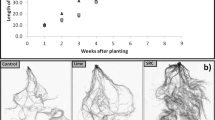Summary
Four experiments are described in which the uptake patterns of various crop species were shown to enhance the solubilization of alkaline rock phosphates. In most cases, such enhancements resulted from soil acidification brought about by the alkaline uptake patterns. In one case, the enhancement may have stemmed primarily from a high Ca-uptake rate, which might be responsible for a shift in mass-action equilibria favoring the solubilization of rock phosphates. High uptake of Ca is expected to serve two purposes: 1. it acts in creating alkaline uptake patterns causing a decline in soil pH, and 2. it promotes a shift in mass-action equilibria.
Similar content being viewed by others
References
Aguilar Santelises A 1981 Rock-phosphate mobilization induced by the alkaline uptake pattern of legumes utilizing symbiotically fixed nitrogen. Doct. Dissertation, Agric. Univ. Wageningen, Neth.
Aguilar Santelises A and van Diest A 1981 Rock-phosphate mobilization induced by the alkaline pattern of legumes utilizing symbiotically fixed nitrogen. Plant and Soil 61, 27–42.
Black C A 1968 Soil-Plant Relationships. John Wiley and Sons, New York, London, Sydney, 792 p.
Breteler H 1973 A comparison between NH4-and NO3 nutrition of young sugarbeet plants grown in nutrient solutions at constant acidity. I. Production of dry matter, ionic balance and chemical composition. Neth. J. Agric. Sci. 21, 227–244.
Dijkshoorn W and van Wijk A L 1967 The sulphur requirements of plants as evidenced by the sulphur-nitrogen ratio in the organic matter. A review of published data. Plant and Soil 26, 129–157.
Hedley M J, Nye P H and White R E 1982 Plant-induced changes in the rhizophere of rape (Brassica napus var. Emerald) seedlings. 2. Origin of the pH change. New Phytol. 91, 31–44.
Hoagland D R and Broyer T C 1936 General nature of the process of salt accumulation by roots, description of experimental methods. Plant Physiol. 11, 471–507.
Johnston W B and Olsen R A 1972 Dissolution of fluorapatite by plant roots. Soil Sci. 114, 29–36.
Khasawneh F E and Doll E C 1978 The use of phosphate rock for direct application to soils. Adv. Agron. 30, 159–206.
Leggett J E, Galloway R A and Gauch M G 1965 Calcium activation of orthophosphate absorption by barley roots. Plant Physiol. 40, 897–902.
Truog E 1916 The utilization of phosphate by agricultural crops including a new theory regarding to feeding power of plants. Wisc. Agr. Exp. Sta. Res. Bull. 41.
Wild A 1964 Soluble phosphate in soil and uptake by plants. Nature London 203, 326–327.
Author information
Authors and Affiliations
Rights and permissions
About this article
Cite this article
Bekele, T., Cino, B.J., Ehlert, P.A.I. et al. An evaluation of plant-borne factors promoting the solubilization of alkaline rock phosphates. Plant Soil 75, 361–378 (1983). https://doi.org/10.1007/BF02369971
Received:
Issue Date:
DOI: https://doi.org/10.1007/BF02369971




